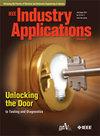Analysis of Inter-Turn-Short Fault in High-Speed Permanent Magnet Generators Considering Effect of Structure Windings
IF 4.2
2区 工程技术
Q2 ENGINEERING, ELECTRICAL & ELECTRONIC
引用次数: 0
Abstract
Inter-turn short faults (ITSF) are common and serious in motor windings, particularly in high-speed motors. To improve the motor performance under the fault as much as possible, it is necessary to clarify the harm of ITSF from high-speed motors with different winding structures. In this article, the influence of ITSF on the properties of high-speed permanent magnet generators (HSPMG) with toroidal winding (TW) and distributed winding (DW) is studied. The TW and DW fault models are established, and the electromagnetic characteristics of the HSPMG after the ITSF are analyzed using the field-circuit coupling method. The temporal and spatial distribution of the air-gap magnetic field under fault is given, and the mechanism of asymmetry in the magnetic field is revealed. Secondly, based on the Fourier transform method, the characteristics of the electromagnetic force under different working conditions are analyzed, and the characteristics of the electromagnetic force harmonic caused by the short-circuit current are obtained. In addition, the vibration acceleration response of the stator is calculated by modal and harmonic response analysis, and the vibration characteristics of the generator after the ITSF are obtained. Finally, the electromagnetic performance of the prototype is tested to verify the correctness of the theoretical analysis.考虑结构绕组影响的高速永磁发电机转间短故障分析
匝间短路故障(ITSF)是电机绕组中常见的严重故障,尤其是在高速电机中。为了尽可能改善故障情况下的电机性能,有必要明确不同绕组结构的高速电机产生的 ITSF 危害。本文研究了 ITSF 对环形绕组 (TW) 和分布式绕组 (DW) 高速永磁发电机 (HSPMG) 性能的影响。建立了 TW 和 DW 故障模型,并利用场-电路耦合方法分析了 ITSF 后高速永磁发电机的电磁特性。给出了故障情况下气隙磁场的时空分布,并揭示了磁场不对称的机理。其次,基于傅立叶变换方法,分析了不同工况下的电磁力特性,得到了短路电流引起的电磁力谐波特性。此外,还通过模态和谐波响应分析计算了定子的振动加速度响应,得到了 ITSF 后发电机的振动特性。最后,对样机的电磁性能进行了测试,以验证理论分析的正确性。
本文章由计算机程序翻译,如有差异,请以英文原文为准。
求助全文
约1分钟内获得全文
求助全文
来源期刊

IEEE Transactions on Industry Applications
工程技术-工程:电子与电气
CiteScore
9.90
自引率
9.10%
发文量
747
审稿时长
3.3 months
期刊介绍:
The scope of the IEEE Transactions on Industry Applications includes all scope items of the IEEE Industry Applications Society, that is, the advancement of the theory and practice of electrical and electronic engineering in the development, design, manufacture, and application of electrical systems, apparatus, devices, and controls to the processes and equipment of industry and commerce; the promotion of safe, reliable, and economic installations; industry leadership in energy conservation and environmental, health, and safety issues; the creation of voluntary engineering standards and recommended practices; and the professional development of its membership.
 求助内容:
求助内容: 应助结果提醒方式:
应助结果提醒方式:


